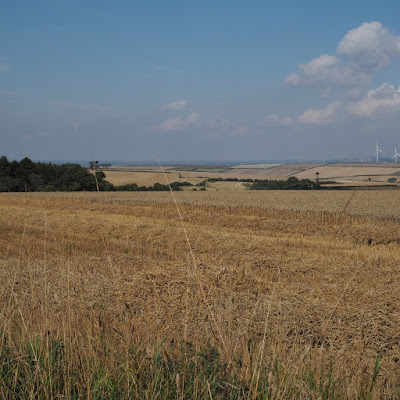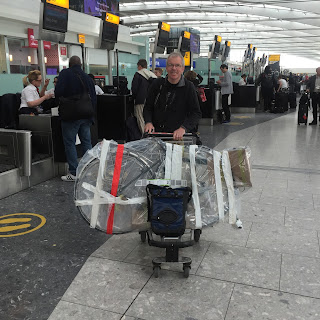North of the Humber there are proper hills, but before I reached them I had to navigate my way out of the Humber Bridge car park and past the M62. The cycle paths are good around here, and well signposted, but they cross busy motorway slip roads and junctions so it's not much fun.
 |
| In the Yorkshire Wolds |
My version of the route took me over the edge of the Yorkshire Wolds through Market Weighton and Pocklington, as I was going to visit friends in the village of Hovingham at the foot of the North York Moors. The route I took wasn't as long as the official one, but it went through proper hills and I was still regretting not seeing more of inland Norway when I was there. This was a fairly hilly day, and the next day was hillier still, as I headed straight through the moors towards Stokesley. It was also very rainy. I got soaked early as I rode into Helmsley and I stopped to dry out in a cafe which was the most expensive of my entire trip. Helmsley is a jumping off point for visitors to the Moors and never lacks tourists. It had stopped raining when I emerged from the cafe, £7 poorer (coffee and a pastry). I climbed up onto the open moorland with great views down into the valley of Rievaulx Abbey shrouded in storm clouds.
 |
| Rievaulx |
 |
| Rain |
The next flurry of rain was not long in arriving, and I made several stops on the way to Stokesley to stand by the roadside beneath my umbrella. However, as I swept down off the moors again the sun came out and, after some searching, I picked up National Cycle Route 1 again in Stockton-on-Tees.
From just north of Stockton the route follows the old mine railway that winds between former pit villages before ending up on the coast at Sunderland. I knew the names of these places - Trimdon and Shotton and Sedgfield carried echoes of the miners' strike in the early eighties, but the beauty of the countryside around here came as a surprise.
 |
| Wheatley Hill miners' memorial |
The lovely Durham countryside was all rolling hills and fields with, eventually, occasional glimpses of the sea in the distance. With the mines gone, the streets of tiny industrial style houses now look oddly out of place, and there are occasional memorials to the mining past.
 |
| On the way to Sunderland |
Apart from very occasional muddy sections the old railway track was a joy to ride on, especially the long, straight descent into Sunderland where the route meandered around before depositing me very close to the centre of town. It was Match Day. Sunderland were playing at home and the wide, sunny streets were full of fans. There was an open, seaside feel to the place as I pushed my bike through the crowds and over the bridge and then followed a beautiful, rocky coastline to South Sheilds, where I found my onward passage blocked by tens of thousands of runners arriving at the finish of the Great North Run. It was completely impossible to cross the road to get where I was going, which was lucky because I cycled along the coastal footpath instead and saw the best part of South Shields, with the Red Arrows thrown in.
 |
| Coastal path at South Shields |
 |
| Red Arrows |
I visited a small lifeboat museum, beckoned inside by an enthusiast standing in the doorway, and then caught the ferry across the Tyne to North Shields along with hundreds of runners who had completed the course.
The coast was still very fine through Tynmouth and Whitley Bay, with long rows of Victorian villas overlooking the sea. North of Blyth the River Blyth forks inland creating a slightly torturous route northwards. Finally I saw a signpost for Newbiggin-by-the-Sea and decided it might be a likely stopping place. It was slightly difficult to persuade the landlady to let me have a single room in her Bed and Breakfast, and when I was installed it was in a tiny room barely big enough for the bed, but with a great view of the sea. In the local pub the talk was all about immigration. At every table people were having the same conversation about Syrian refugees. 'We wouldn't want them here though, they'd change the place, wouldn't they?' Did you see? They were all young men. They're not real refugees, are they?'
I'd hardly seen a black or a brown face since I'd arrived in Sunderland.
It was the unknown they were frightened of.
Maps:
to Hovingham; to Fishburn; to Newbiggin-by-the-Sea











Comments
Post a Comment